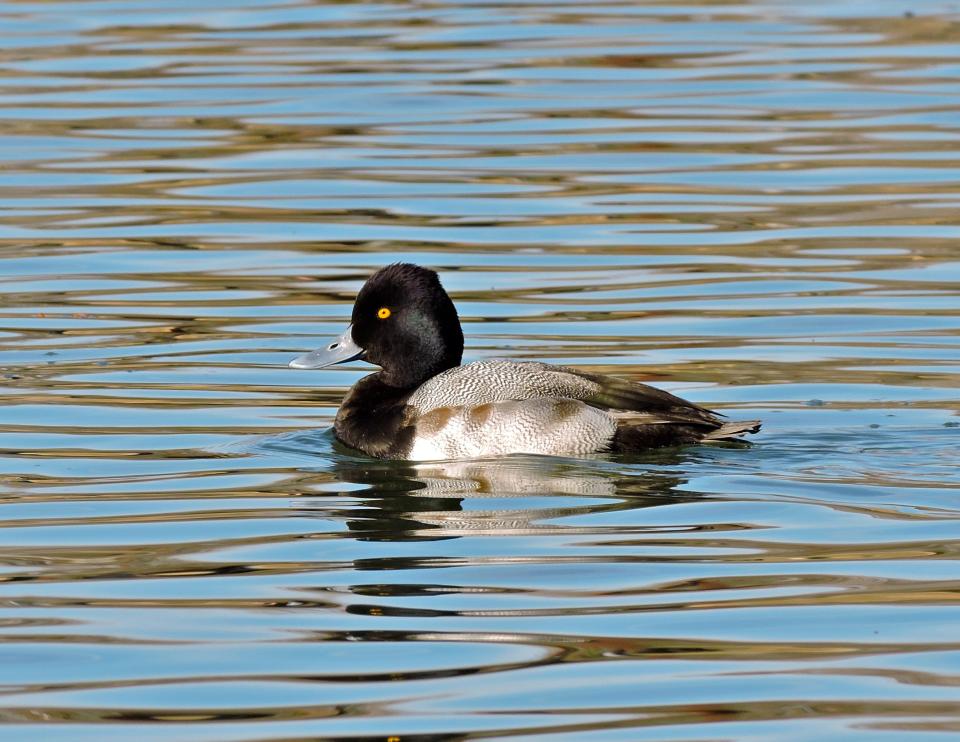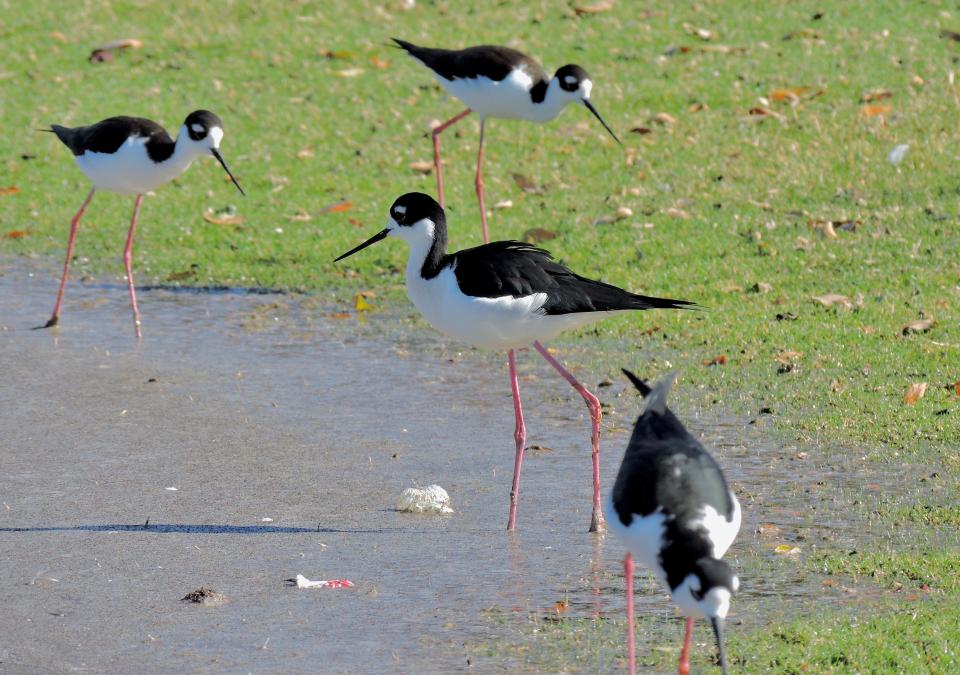For some of the best birding in Arizona, try this less-visited destination. Here's how
Arizona's Sky Islands are known around the world as a birding mecca. Birders who visit the southeastern part of the state can find species such as the violet-crowned hummingbird, Montezuma quail and elegant trogon.
But this isn't the only place in Arizona to see a great diversity of resident and migratory birds.
The less-visited Bill Williams River National Wildlife Refuge, along the Colorado River in western Arizona, is a 6,105-acre wildlife haven that sees over 340 species of birds annually.
Why does this off-the-beaten-path environment teem with so many species? The Arizona Republic talked to Steven Prager, education biologist for Audubon Southwest, to learn what makes the area an ideal habitat for so many kinds of birds.
Here is everything you need to know about Bill Williams River National Wildlife Refuge near Parker, Arizona.
More: Fun things to do on your trip to Parker and western Arizona
What types of birds can you see in western Arizona?
The Bill Williams River marks the transition zone between the Mojave and Sonoran deserts and is a melting pot of wildlife from both. More than 340 species of birds have been recorded there, per the U.S Fish and Wildlife Service.
Prager said there are three ways to categorize the birds there.
Resident birds: Birds that live, breed and winter at the refuge are classic desert birds you can spot any time of the year, including verdin, Abert‘s towhee, cactus wren, Gila woodpecker and yellow-rumped warbler.
Wintering migrants: In winter the refuge sees a big population of shore birds from the north, including Western sandpiper and spotted sandpiper as well as waterfowl such as ducks.
Summer breeders: These birds spend the summer months at Bill Williams and winter in the south. They include the summer tanager, yellow-billed cuckoo, Southwestern willow flycatcher and yellow-breasted chat.
More: Best bird watching in Arizona: Hot spots and species to look for
Why does the Bill Williams River attract so many birds?
The Bill Williams River National Wildlife Refuge, a 9-mile corridor and delta, is the last extensive naturally flood-regenerated riparian and wetlands habitat on the lower Colorado River, according to Audubon’s Arizona Important Bird Areas Program. A riparian forest is a forested area next to a body of water.
The refuge's year-round water and riparian vegetation create a hospitable microclimate in an area that typically has low rainfall and temperatures exceeding 100 degrees, per the IBA.
“We've lost over 90 percent of that habitat type in the state since before settling or colonization here, Prager said.
“So having that forest intact is a big thing for birds and that's especially healthy because Alamo Dam, upstream from the refuge, releases water from that reservoir in a way that mimics natural seasonal flooding and creates a really healthy mesquite forest along the edges of the river and really valuable wetland marsh habitat.
"To see that kind of seasonal flooding, as we have dammed, diverted and otherwise screwed up our rivers around the state, is a really unique thing to see.
"It's a really healthy large patch of river, which is increasingly rare, and the Colorado River itself is a major north to south mandatory corridor for birds. So it is very well positioned geographically to have a lot of birds passing by.”
More: Best birding hikes in Arizona: Where to see trogons, owls, tanagers and more

What months are best for bird watching?
There are two prime times of year for bird watching at Bill Williams River National Wildlife Refuge, Prager said.
“In the middle of the winter months, in December and in January, you are going to have a great diversity to the end of the refuge closer to (Lake) Havasu where there is a lot of open water. You are going to see a lot of ducks, shore birds and wintering raptors like bald eagles and peregrine falcons," he said.
"If you go there during summer months and head to the riverside of the refuge a little bit further away from Lake Havasu, you are going to see those breeding tropical migrants like warblers, chats, tanagers and orioles.”
What rare birds can you see in western Arizona?
Astute birders have a chance to spot rare and endangered birds at the refuge. Prager said notable varieties include the Southwestern willow flycatcher and the yellow-billed cuckoo, which are endangered species.
In summer you might see a Nutting’s flycatcher. Prager said the refuge is one of the few places in the United States where Nutting’s flycatcher breeding has been documented.
The refuge is also a special place for Clark's nutcrackers and Western grebes, Prager said. These can mostly be seen near the mouth of the Bill Williams River.
Why do birds migrate to western Arizona?
It's more complicated than simply the change of seasons, Prager said. Birds' movement is triggered by seasonal fluctuations in availability of food and other resources that birds need to survive.
“For birds to breed or to survive the winter, they're going to need a plentiful food source,” Prager said. “They'll leave during the less productive season to another spot where the resources exist for them to do what they need to do.
"And it gets messier than that. If you think about birds that are coming down from the north, they're going to end up in the range of birds that were already there. So there's increased competition and all sorts of things that can influence when and where birds move.”

Things to do at Bill Williams River National Wildlife Refuge
Stop at the visitor center: It's on State Route 95 about 16 miles north of Parker. You can pick up a brochure and get information about the area.
Walk the nature trails: Two easy trails — each about a half-mile long — begin near the visitor center. The Peninsula Trail is partly paved and meanders past signs that give you information about the ecosystem. There are benches along the way where you can relax and soak up the views. The Delta Loop Trail is a half-mile loop that follows the shoreline of the Bill Williams River delta.
Explore the refuge: Activities include kayaking, hunting, boating, birding, fishing and a scenic drive. For an overview of the landscape, take the 7-mile round trip drive along Planet Ranch Road for mountain, river and wooded views. Get out and stretch your legs at pullouts along the way. High-clearance vehicles are recommended for this dirt and gravel road.
Environmental concerns at the refuge
These activities and environmental conditions affect the refuge, Prager said.
Climate change: Drought driven by climate change could diminish the water flow. “It will likely impact operations at the Alamo Dam, which can affect their ability to deliver on those seasonal flows that have benefited the refuge so much,” Prager said.
Off-highway vehicle travel: Vehicles that go off established roads and drive through washes or river corridors damage the habitat. “You end up tearing up soil and vegetation and that prevents the river system from recruiting new plants," Prager said.
Wind energy development: While Audubon is in favor of renewable energy, Prager said, where wind farms are built is of concern to the organization.
“That lower Colorado River corridor often comes up as a potential place for wind farms,” he said. "You can imagine as big of a migratory corridor as it is that siting becomes complicated, and making sure those get put in the right place so they're not colliding with birds can be real important."
Grazing: “There is a lot of active grazing still going on around the refuge, so making sure the cattle are placed appropriately and are in places where they're supposed to be” is important, Prager said.
Boating: Boats make waves that disturb the marsh habitat where birds nest. There are closures around the mouth of the Bill Williams River near Lake Havasu to protect these areas.
Invasive species: Nonnative plant species like tamarisk can take over river systems, push out cottonwoods and willows and deplete the water table. Tamarisk also is a fire hazard.
Nonnative aquatic species like zebra mussels hook onto boats and establish themselves in new water systems. According to Arizona Game and Fish, zebra mussels remove phytoplankton from the water, which disrupts its ecological balance.
How you can help
Boat responsibly: Keep out of closed areas and drive slowly near the mouth of the refuge so you don't disturb the habitat.
Be a proactive birder: Submit information and photos of the birds you see at https://ebird.org/home. “That is how we learn what is there and what is using the space because our biologists can’t be everywhere all the time,” Prager said.
Stay informed: Check out the Audubon’s Western Rivers Action Network. You can sign up to receive alerts about water issues and other topics that affect birds nationwide.
Bill Williams River National Wildlife Refuge
When: Visitor center is open 8 a.m.-4 p.m. Mondays-Fridays and 10 a.m.-2 p.m. Saturdays and Sundays.
Where: 60911 State Route 95, Parker.
Admission: Free.
Details: https://www.fws.gov/refuge/bill-williams-river.
More things to do in western Arizona
The Bill Williams River National Wildlife Refuge is just one highlight of western Arizona. Here are other things to do in and around Parker.
Desert Bar: The Desert Bar is an open-air watering hole near Parker whose claims to fame are its remoteness — 5 miles down a rugged dirt road — and its quirky architecture built over 40 years by owner Ken Coughlin.
More: Desert Bar will never be done, and that's just how the owner likes it
Buckskin Mountain State Park: This park is on the Colorado River just over 6 miles from the refuge. Rolling mountains line the California and Arizona sides of the river. There are 80 campsites for RVs and tents, and fishing, boating and swimming are available in designated areas. Amenities include restrooms, hiking trails and a small store with snacks and souvenirs.
You can connect with Arizona Republic Culture and Outdoors Reporter Shanti Lerner through email at shanti.lerner@gannett.com or you can also follow her on Twitter.
Support local journalism like this story by subscribing today.
This article originally appeared on Arizona Republic: Best birding areas in Arizona: Bill Wlliams River refuge

